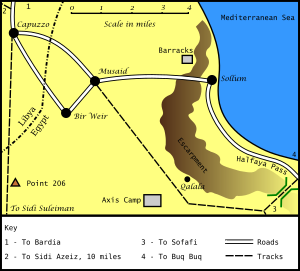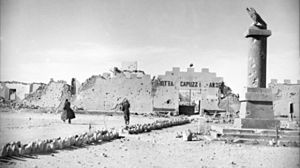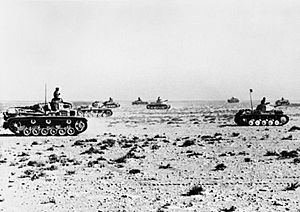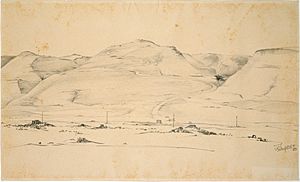Operation Brevity facts for kids
Quick facts for kids Operation Brevity |
|||||||
|---|---|---|---|---|---|---|---|
| Part of the Western Desert Campaign of the Second World War | |||||||
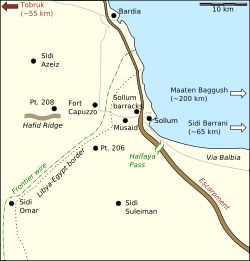 The Egyptian and Libyan border over which Operation Brevity was conducted. |
|||||||
|
|||||||
| Belligerents | |||||||
| Commanders and leaders | |||||||
| Archibald Wavell William Gott |
Erwin Rommel Maximilian von Herff Italo Gariboldi |
||||||
| Strength | |||||||
| 3 infantry battalions 53 tanks |
Elements of several battalions 30–50 tanks |
||||||
| Casualties and losses | |||||||
| 206+ casualties 5 tanks destroyed 6 aircraft destroyed |
605+ casualties 3 tanks destroyed |
||||||
Operation Brevity was a short military attack during World War II in May 1941. It took place in the Western Desert Campaign, near the border between Egypt and Libya. The British commander, General Archibald Wavell, planned this attack. He wanted to quickly strike at the weaker forces of the Axis powers (Germany and Italy) in the areas of Sollum, Capuzzo, and Bardia.
The operation started well, confusing the Axis leaders. However, the British soon lost most of their early gains due to enemy counter-attacks. When German reinforcements arrived, the operation was stopped after just one day.
Contents
Why the Battle Happened
In September 1940, Italian forces from Libya invaded Egypt. But by February 1941, British forces had pushed far into Libya. They destroyed the Italian Tenth Army. After this, Britain focused on helping Greece, which was threatened by an Axis invasion. Many Allied troops were moved from North Africa.
While this happened, Italy strengthened its forces. Germany also sent its Afrika Korps to help, led by General Erwin Rommel. Rommel quickly attacked the British and Commonwealth forces. By April 1941, he had pushed them back to the Egyptian border.
Even though the main fighting was at the border, the city of Tobruk in Libya held out. Its British and Australian defenders were a big threat to Rommel's long supply lines. So, Rommel focused on trying to capture Tobruk. This left the front line at the border with fewer Axis troops.
General Wavell saw a chance to attack. He wanted to capture land to help a bigger attack on Tobruk later. He also hoped to weaken the German and Italian forces.
Planning the Attack
General Wavell named his plan Operation Brevity. He wanted a quick strike in the Sollum area. His main goals were to take back the Halfaya Pass, push the enemy out of Sollum and Capuzzo, and weaken Rommel's forces. A smaller goal was to move towards Tobruk, but only if it was safe.
British Forces
Brigadier William Gott led the British attack. He had three main groups of soldiers and tanks.
- Southern Group: This group had 29 cruiser tanks and armoured cars. Their job was to move through the desert, destroy any enemy they found, and patrol the area.
- Central Group: This group included two infantry battalions and 24 infantry tanks. They were to clear the top of Halfaya Pass, secure Bir Wair and Musaid, and capture Fort Capuzzo.
- Coastal Group: This group had infantry and artillery. They were to advance along the coast road, capturing the lower Halfaya Pass, Sollum barracks, and the town of Sollum.
Axis Forces
The main German and Italian forces were led by Colonel Maximilian von Herff. They had 30–50 tanks and Italian motorized infantry. The Halfaya Pass was defended by tough Italian infantry called Bersaglieri, with artillery support.
The Germans knew a British attack was coming. On May 13, Axis planes bombed British tank groups. Herff expected the attack soon.
The Battle Begins
On May 15, 1941, at 6:00 AM, the three British groups began their advance. British fighter planes flew overhead to support them.
Central Group's Fight
The Central Group reached the top of Halfaya Pass. They met strong resistance from Italian Bersaglieri soldiers. The Italians fought bravely. Their anti-tank guns could not pierce the thick armor of the British Matilda tanks. So, they aimed at the tanks' tracks and undersides. They disabled seven tanks this way. Despite the losses, the British took the position and pushed on. By 10:15 AM, they had captured Bir Wair and Musaid.
Next, British tanks and infantry moved towards Fort Capuzzo. German tanks and anti-tank guns were hidden near the fort. They disabled five British tanks but were forced to retreat. The British infantry attacked the fort without tank support at first. But with reinforcements, they captured Fort Capuzzo just before midday.
Later that afternoon, a small group of Scots Guards moved towards Bardia. They faced heavy machine gun fire. A group of Universal Carriers, led by Sergeant F. Riley, bravely charged the enemy guns, silencing them and taking prisoners. Riley was awarded a medal for his courage.
Desert Group's Action
On the desert side, the British tanks advanced. They found German armored vehicles. They disabled one German tank and forced two others to retreat. By midday, this group was west of Fort Capuzzo.
Coastal Group's Advance
The Coastal Group, without tank support, faced strong Italian resistance at the bottom of Halfaya Pass. They were held up all morning. Finally, in the evening, British and Australian soldiers overran the Italian positions, taking about 130 prisoners.
Axis Counter-Attacks
Operation Brevity surprised the Germans and Italians. Rommel noted that the first British attacks caused him many losses. By midday, the Axis command was confused. They thought the British had over 100 tanks. They asked their air forces to attack the British.
The Germans focused their counter-attack on the Central Group. Colonel Herff launched an attack on Fort Capuzzo that afternoon. At about 1:30 PM, the British company at the landing ground was overrun. Without strong anti-tank weapons, the British were forced to retreat. By 2:45 PM, the Germans reported they had recaptured Capuzzo, causing heavy losses to the British.
On the desert flank, the Germans saw the British tanks but thought they were heavily armored Matilda tanks. They decided not to attack. Herff, believing the British had many more troops, decided to pull back and join up with German tank reinforcements for a bigger attack the next morning.
British Withdrawal
Brigadier Gott realized his troops were in danger from German tank attacks in the open desert. So, in the early hours of May 16, he pulled them back. By 10:00 AM, the infantry were back at Halfaya Pass.
German reinforcements arrived and joined Herff's forces. They tried to advance but ran out of fuel. Later, they resumed their advance but were stopped by British tanks. As night fell, Herff stopped the attack, planning to reorganize and attack again on May 18. The British tanks also pulled back.
What Happened Next
Operation Brevity did not achieve most of its goals. The British only managed to retake the Halfaya Pass. The British lost five tanks destroyed and 13 damaged. Over 200 British soldiers were killed, wounded, or captured. The Germans lost three tanks and over 250 men. The Italians lost nearly 400 men.
Rommel praised the Italian Bersaglieri who defended Halfaya Pass. He said they fought "with lionlike courage." Lieutenant Giacinto Cova, an Italian platoon commander, received Italy's highest bravery award for his actions.
British Prime Minister Winston Churchill sent a message to Wavell, praising the attack. He mentioned new tanks (called "Tiger cubs") that had arrived, which would help the British prepare for a bigger attack to relieve Tobruk.
Operation Brevity showed Rommel how important the Halfaya Pass was. It was a safe route for supplies during attacks. So, on May 27, just 11 days later, Rommel launched Operation Skorpion. In this attack, Herff recaptured the Halfaya Pass, taking back the last British gain from Operation Brevity.
See also
- Operation Brevity order of battle
- North African campaign timeline
- List of British military equipment of World War II
- List of German military equipment of World War II
- List of Italian military equipment in World War II


